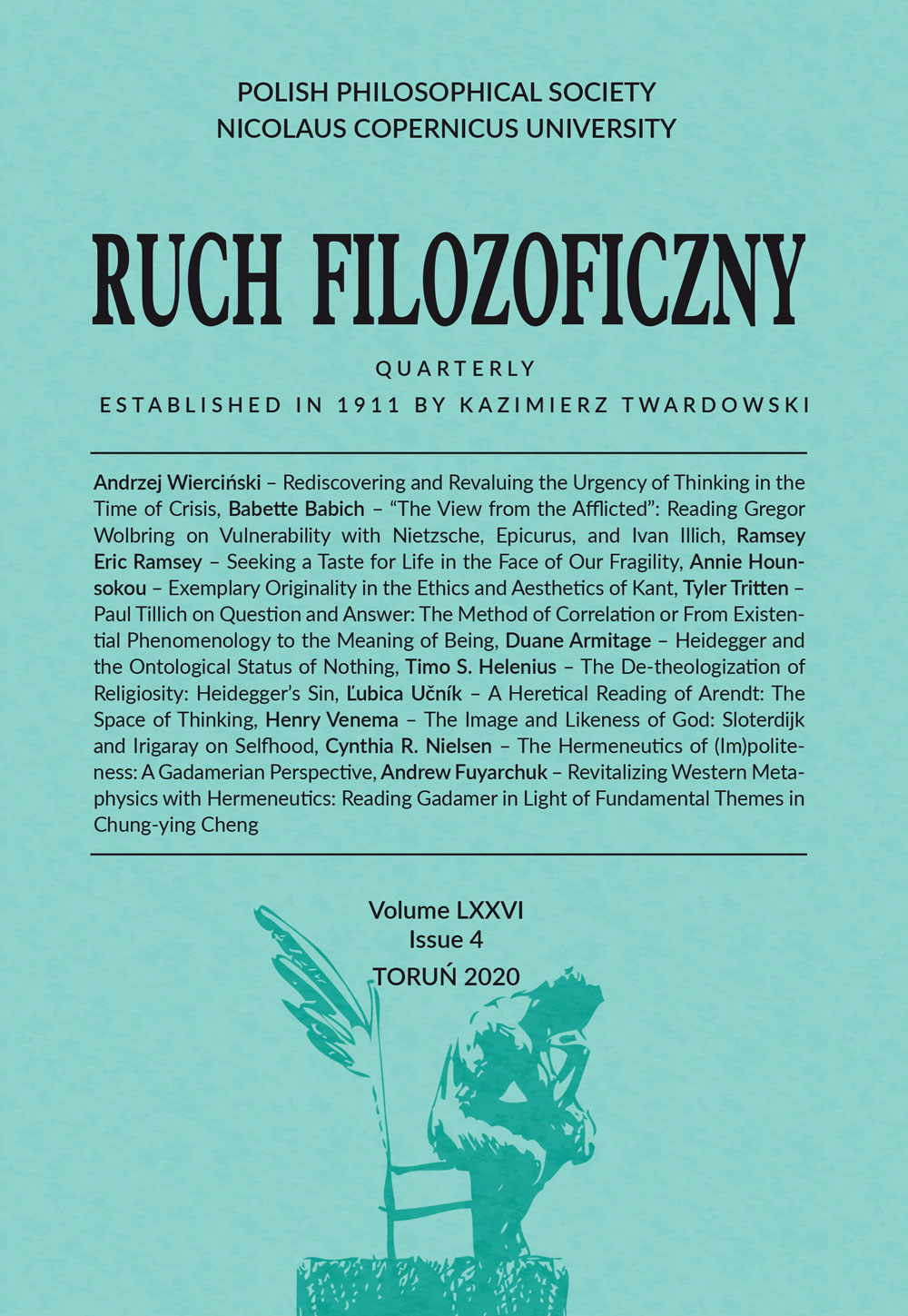The Image and Likeness of God: Sloterdijk and Irigaray on Selfhood
DOI:
https://doi.org/10.12775/33067Słowa kluczowe
Sloterdijk, Irigaray, selfhoodAbstrakt
The Cartesian ghosts of modernism are incapable of understanding selfhood. By taking the individual as the ontological foundation for philosophical inquiry, selfhood is abstracted from the fullness of flesh and blood reality and fails to see selfhood as a plurality of interconnections with others that are essential to any attempt at self-understanding. As Paul Ricoeur points out, the self is discipled into selfhood by way of others who are there prior to any notion we may have about our own identity. We pass through a hermeneutical “detour” by way of the other to come back to self. Here we discover what we take as self is in fact given to us by persons, texts and our historical situation. Selfhood is a self in relation with others, and therefore self-knowledge must consider our relational openness to otherness as foundational for who? what? where? and why? we are constituted in this way. It is this relation, or relational space between self and other that I want to explore in this paper.
Bibliografia
Bauman Zygmunt. 2000. Liquid Modernity. Cambridge: Polity Press.
Derrida Jacques, Maurizio Ferraris. 2001. I have a taste of the secret, transl. Giacomo Donis, ed. Giocomo Donis and David Web. Cambridge: Polity Press.
Dooyeweerd Herman. 1999. In the Twilight of Western Thought: Studies in the Pretended Autonomy of Philosophical Thought. Lewiston: Edwin Mellen Press.
Fox Mathew. 2000. Original Blessing. New York: Jeremy P. Tarcher/Putnam.
Girard René. 1996. The Girard Reader, ed. James G. Williams. New York: The Crossroads Publishing Co.
Girard René. 2010. Battling to the End: Conversations with Benoit Chantre, transl. Mary Baker. East Lansing: Michigan State University Press.
Irigaray Luce. 2002. The Way of Love. New York: Continuum.
Kearney Richard. 2001. The God Who May Be: A Hermeneutics of Religion. Bloomington: Indiana University Press.
Latour Bruno. 2009. “Spheres and Networks: Two ways to Reinterpret Globalization”. Harvard Design Magazine 30, Spring/Summer.
Olthuis James H. 2001. The Beautiful Risk: A New Psychology of Loving and Being Loved. Grand Rapids: Zondervan.
Ricoeur Paul. 1998. Critique and Conviction: Conversations with Francois Azouvi and Marc de Launay, transl. Kathleen Blamey. New York: Columbia University Press.
Saint John of Damascus. 1958. “An Exact Exposition of the Orthodox Faith.” In: Saint John of Damascus. Writings, transl. Fredric H. Chase. New York: Fathers of the Church, Inc.
Sloterdijk Peter, Hans-Jurgen Heinrichs. 2011. Neither Sun nor Death, transl. Steve Corcoran. Los Angeles, CA: Semiotext(e).
Sloterdijk Peter. 2011. Spheres Volume 1: Bubbles, Microsphereology, transl. Wieland Hoban. Los Angeles, CA: Semiotext(e).
Sloterdijk Peter. 2014. Spheres Volume 2: Globes, Marcospherology, transl. Wieland Hoban. Los Angeles, CA: Semiotext(e).
Sloterdijk Peter. 2016. Spheres Volume 3: Foam, Plural Spherology, transl. Wieland Hoban. Los Angeles, CA: Semiotext(e).
Venema Henry Isaac. 2000. Identifying Selfhood: Imagination, Narrative, and Hermeneutics in the Thought of Paul Ricoeur. New York: SUNY Press.
Venema Henry Isaac. 2003. “Who am I to Others?”. In: International Institute for Hermeneutics, Hermeneutical Series, Vol 3, Between Suspicion and Sympathy: Paul Ricoeur’s Unstable Equilibrium, ed. Andrzej Wierciński. Toronto: The Hermeneutic Press.
Žižek Slavoj. 2014. Event, Philosophy in Transit. London: Penguin Books.
Pobrania
Opublikowane
Jak cytować
Numer
Dział
Statystyki
Liczba wyświetleń i pobrań: 1111
Liczba cytowań: 0



